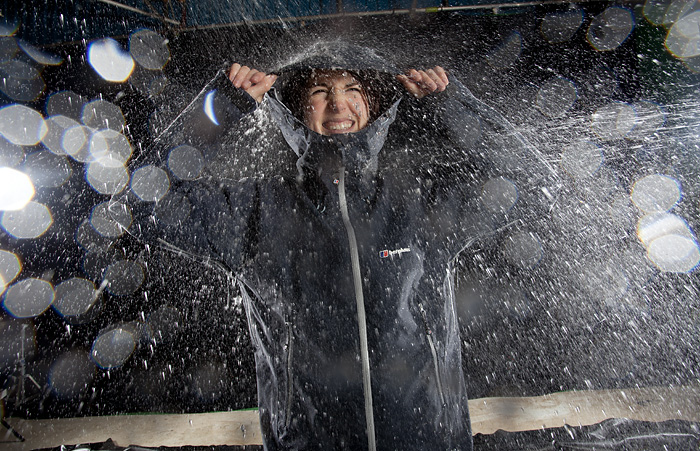I share a lot in common with my cameras and lighting in that I don’t like getting wet, too hot, dusty or dropped. Studio lighting and water is, to put in mildly, a dangerous accident waiting to happen. Even battery powered lighting will carry a huge voltage stored up in capacitors so using five heads whilst drenching brave reviewer Jo with hoses, watering cans, water pistols and buckets may not have been a good idea. At least she was wearing waterproof coats. Read more for the setup!
This shoot was for BBC Focus magazine testing waterproof jackets. A variety of tests were devised, from an overhead watering can (showers) to a direct blast from a hose (angry neighbour watering garden).

The studio setup.
I set up the lighting with two considerations, number one to achieve enough side light to capture the water and number two doing so without electrocuting anyone. As you can see there are four side lights, two either side, all blocked off to stop lighting spilling into the lens. A single head into a foam board is acting as the main fill light (this was wrapped in a plastic bag during the shoot). We made a small paddling pool which captured most of the water and, because we were throwing water from one side, the back board stopped us from soaking the entire studio. Kind of.
For the actual shot above I’d donned full waterproofs and got very close on a 17-40mm lens. As much as I didn’t like the light spill at first I think the light flaring enhances the picture. I’d wrapped my 5D II and lens in a large sandwich bag, punching a hole in the end and taping it on to the UV filter of the lens. It worked fine, with no water getting into the bag at all. The softer highlights in the picture are where water droplets on the lens have caught the light and it gives the picture a nice depth.
As a bonus nobody was electrocuted and died. Which I consider a plus.

